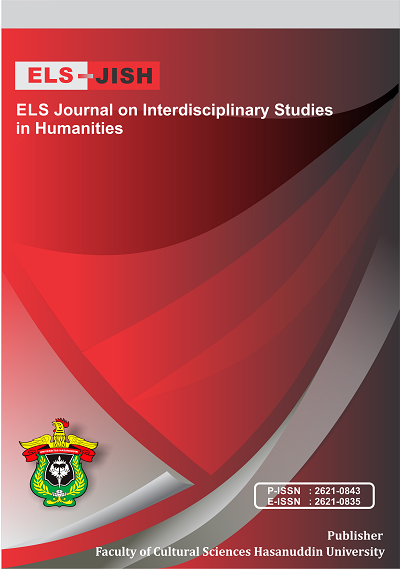Non-Verbal Communication by Autistic Children
DOI:
https://doi.org/10.34050/elsjish.v3i4.8065Keywords:
Autistic Children, Non-Verbal Communication, KinesicsAbstract
This paper entitled ‘Non-Verbal Communication by Autistic Children’ was conducted with the aim to find out the components of kinesics as a part of nonverbal communication expressed by autistic children when interacting with their teachers at SLB ABC Taman Pendidikan Islam. Beside that this study also intended to know the meanings of those kinesics components expressed by autistic children when interacting with their teachers. This research used a descriptive qualitative approach by applying kinesics theory by Ray Birdwhistell. The data collection techniques were conducted by using non-participant observation techniques and documentation. The documents used to support this study were in the form of photographs and video recorder that showed the communication done by the autistic children with their teachers during the learning process in the class. The results showed that although autistic children cannot interact clearly through verbal communication, they can express their desires through non verbal communication. They can communicate by expressing it through facial expressions, eye contact, body movement, posture and touch. The meaning of the non-verbal communication expressed by each autistic child has a different meaning. This study also intended to give worthy contribution to all people who want to understand the non-verbal communication of autistic children.
References
Alshurman, W., & Alsreaa, I. (2015). The Efficiency of Peer Teaching of Developing Non Verbal Communication to Children with Autism Spectrum Disorder (ASD). Journal of Education and Practice, 6(29), 33–38.
Birdwhistell, R. L. (1970). Masculinity and femininity as display. Kinesics and Context: Essays on Body Motion, 39–46.
Birdwhistell, R. L. (1979). Kinesik. KR Scherer, HG Wallbott (Hg.): Nonverbale Kommunikation: Forschungsberichte Zum Interaktionsverhalten. Weinheim, 192–202.
Borg, J. (2009). Buku pintar memahami bahasa tubuh. Terj. Abdul Hamid. Yogyakarta: THiNK.
Cadette, J. N., Wilson, C. L., Brady, M. P., Dukes, C., & Bennett, K. D. (2016). The effectiveness of direct instruction in teaching students with autism Spectrum disorder to answer “wh-” questions. Journal of Autism and Developmental Disorders, 46(9), 2968–2978.
Gardner, H. (1999). Intelligence Reframed: The Theory in Practice. New York City, NY: Basic Books.
Jordan, R., & Powell, S. (1995). Understanding and Teaching Children with Autism. Wiley.
Montagu, A. (1984). The skin, touch, and human development. Clinics in Dermatology, 2(4), 17–26.
Prevezer, W., Newson, E., Christie, P., & Chandler, S. (2009). First Steps in Intervention with your Child with Autism: Frameworks for Communication. Jessica Kingsley Publishers.
Rasyid, R. (2014). Perilaku Komunikasi Nonverbal Anak Autis Dalam Proses Belajar di Sekolah Luar Biasa (SLB) Pembina Tingkat Provinsi Sulawesi Selatan di Kota Makassar.
Sukmadinata, N. S. (2011). Metode Penelitian dan Pendidikan. Bandung: PT Remaja Rosdakarya.
Sunardi, S. (2007). Intervensi Dini Anak Berkebutuhan Khusus. Jakarta: Departemen Pendidikan Nasional.
Tammasse, Jumraini, & Rahman, F. (2019). Some difficulties in verbalizing English words and phrases: A case study of suspected dyslexic children. Asian EFL Journal, 26(6), 73–85.
Downloads
Published
How to Cite
Issue
Section
License
Copyright (c) 2020 ELS Journal on Interdisciplinary Studies in Humanities

This work is licensed under a Creative Commons Attribution-NonCommercial 4.0 International License.






